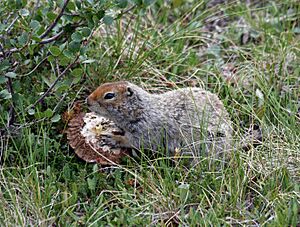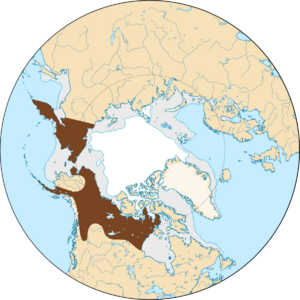Arctic ground squirrel facts for kids
Quick facts for kids Arctic ground squirrel |
|
|---|---|
 |
|
| Conservation status | |
| Scientific classification | |
| Genus: |
Urocitellus
|
| Species: |
parryii
|
| Subspecies | |
|
10 ssp., see text |
|
 |
|
| Synonyms | |
|
Spermophilus parryii |
|
The Arctic ground squirrel (Urocitellus parryii) (Inuktitut: ᓯᒃᓯᒃ, siksik) is a type of ground squirrel that lives in the very cold Arctic and Subarctic parts of the world. You can find them mostly in North America and Asia. In some parts of Alaska, especially near the Aleutian Islands, people call them "parka" squirrels. This is because their warm fur was often used to make the ruffs on parkas and other clothes for cold weather. These small rodents are well-known for their amazing ability to survive in freezing temperatures.
Contents
The Arctic Ground Squirrel: A Tundra Survivor
What Does It Look Like?
The Arctic ground squirrel usually has light brown or tan fur with some spots on its back. It has a shorter face and smaller ears compared to squirrels that live in trees. This helps it with its burrowing lifestyle. You might notice dark fur on its tail and white marks around its eyes.
Every summer, during the time of the Midnight sun, these squirrels shed their old fur and grow a new coat. This is called molting. It helps them get ready for the cold winter ahead. Other Arctic animals, like the Arctic fox and Arctic hare, also change their coats. In summer, their fur can have reddish and yellow colors on their cheeks and sides. But in the fall, these red patches are replaced by a more silvery color. This lighter winter coat helps them blend in with the snow. This makes it harder for predators like snowy owls or foxes to spot them.
An adult Arctic ground squirrel is about 39 centimeters (about 15 inches) long. Their weight changes a lot throughout the year. Adult females weigh around 750 grams (about 1.6 pounds), while males can be nearly 100 grams (about 0.2 pounds) heavier. They gain a lot of weight before winter to help them survive hibernation.
Where Do They Live?
You can find Arctic ground squirrels in western Northern Canada. This includes the Yukon, northern British Columbia, and the Northwest Territories. They also live across Alaska, including the Aleutian Islands. Their range even reaches the Russian Far East in Siberia, like the Kamchatka Peninsula. Some special types live on specific islands, such as St. Lawrence Island and Kodiak Island.
These squirrels have adapted to live on the tundra in the North American Arctic. They often choose to live on hillsides, mountain slopes, or near rivers and lakes. They love sandy soil because it's easy to dig their burrows in and drains water well. They dig shallow tunnels and burrows in places where the ground, called permafrost, won't stop them from digging. In warmer, more southern areas, they live in open meadows and tundra.

Different Kinds of Arctic Ground Squirrels
Just like there are different breeds of dogs, there are also different types, or subspecies, of Arctic ground squirrels. Scientists have given each of these slightly different groups their own special names. For example, one type lives on St. Lawrence Island and another on Kodiak Island.
Amazing Behaviors
These busy squirrels are active during the day on the tundra. They need to be careful because many animals hunt them. Their predators include the Arctic fox, red fox, wolverine, Canada lynx, brown bear, snowy owl, and eagles.
They are one of the few Arctic mammals that hibernate during the winter. This is similar to how little brown bats and marmots sleep through the cold months. In the summer, they eat lots of tundra plants, seeds, and fruit. This helps them build up body fat for their long winter sleep. Before winter, male squirrels also store food in their burrows. This way, they have something to eat when they wake up in spring, before new plants grow. Their burrows are cozy, lined with things like lichens, leaves, grasses, and even muskox hair.
Squirrels talk to each other in different ways. They touch noses or press their bodies together when they meet. They also make "tsik-tsik" calls when they sense danger. These calls change depending on the type of predator. Deep sounds warn about animals on the ground, while short, whistling sounds mean danger from the air.
Hibernation Secrets
Arctic ground squirrels are champions of hibernation! They sleep through the winter, usually from early August to late April for females. Males hibernate from late September to early April. During this long sleep, their body temperature drops dramatically. It can go from a normal 37 degrees Celsius (98.6°F) down to an amazing -3 degrees Celsius (26.6°F)! Their heart rate also slows down to about one beat per minute.
Even their blood and other body parts get super cold, below freezing. How do they not freeze solid? Scientists believe these squirrels can remove special "ice nucleators" from their bodies. These nucleators are tiny particles needed for ice crystals to form. Without them, their body fluids can stay liquid even when supercooled. Scientists are studying this amazing ability. They hope to learn how to better preserve human organs for transplant, using what they discover from these squirrels.
During hibernation, the connections between their brain cells also shrink. This sounds serious, but research shows these connections grow back when the squirrels wake up. In the warmer months, these squirrels are very active during the day.
What's on the Menu?
Arctic ground squirrels eat a variety of foods. They munch on grasses, sedges, mushrooms, bog rushes, bilberries, willows, roots, stalks, leaves, and flowers. They also enjoy seeds and catkins. Sometimes, they eat insects. Occasionally, they even eat carrion (dead animals) like mice, snowshoe hares, or caribou. They have even been known to eat young Arctic ground squirrels. These clever squirrels sometimes carry food back to their dens in their cheeks, like a built-in shopping bag!
Life Cycle and Young
When it's time to mate, males will compete with each other to find a female. Arctic ground squirrels live alone in their burrow systems. Mating happens between mid-April and mid-May, after they wake up from hibernation. Often, a litter of pups can have fathers from different males.
A mother squirrel is pregnant for about 25 days. She then gives birth to a litter of 5 to 10 tiny, hairless pups. Each pup weighs about 10 grams (less than half an ounce). After about six weeks, the pups stop drinking their mother's milk and start eating solid food. They then grow very quickly to get ready for their first winter.
A Look Back in Time
Arctic ground squirrels have been around for a very long time! Scientists have found many fossils of these squirrels from a period called the Pleistocene. This shows us that they were common in many places where they don't live today. By studying their old nests and food stashes, scientists can learn about what the environment was like thousands of years ago. For example, they found certain plant remains in old squirrel stashes in Alaska. This tells us what kinds of plants grew there long ago.
Keeping Them Safe
The Arctic ground squirrel population is considered "secure" by Environment Yukon (a government group in Canada). The IUCN Red List, which tracks how endangered animals are, lists the Arctic ground squirrel as "least concern." This means they are not currently at high risk of disappearing.
Images for kids
-
An Arctic ground squirrel in the Alaska Maritime National Wildlife Refuge






